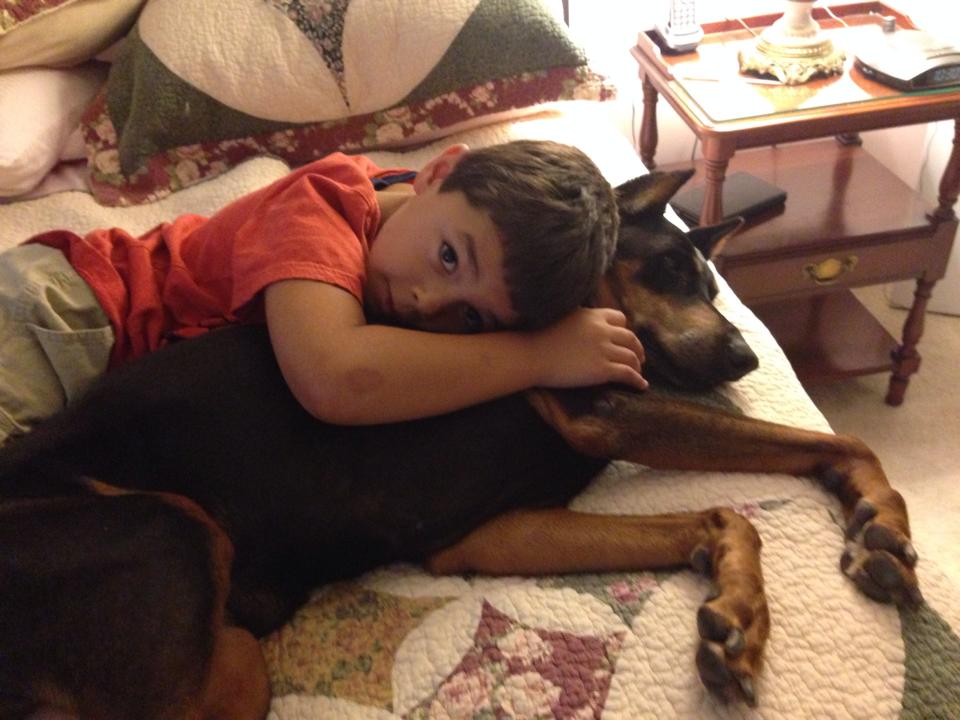I recently had to help my mom and dad put their Doberman to sleep. Sadie was on medication for hypothyroid, incontinence, and we’d found a nodule in her lung about a year ago, but Sadie had a joie de vivre that just wouldn’t quit and she loved her life as a spoiled rotten princess.
About 15 years ago, I knew my mom was considering getting a dog. I was working in a primary care practice at the time and we had a client who had had an unwanted puppy thrust upon him by a family member. He brought in the 7 month old puppy and wanted us to “fix” her ears. She had had her ears cropped a few months earlier and was now living in a pen – we had to explain to this gentleman that what she looked like now was all he was going to get (one ear stood and one ear was wonky and usually laid on top of her head).
This client mentioned in passing that he was trying to find the pup a home, and I immediately set about getting a meeting arranged. Mom and the puppy hit it off and mom agreed to a trial run. Keep in mind, my mom was not what anyone thought of as a “big dog” sort of person; but when she followed me to my house in her car and I looked in my rearview mirror to see a Doberman head resting on mom’s shoulder as she drove, I knew it was a done deal.
Sadie was an amazing companion for mom and dad, especially mom – their bond was incredibly close. When the two of them traveled with Sadie, she was watchful and alert. But when mom travelled alone, no strange man ever approached mom; that deep voice and those big teeth were an effective deterrent. She was also fantastic with the kids when the grandkids started arriving.
Of course, I saw Sadie every time I went home to visit and she was often at my house when I would pet-sit for Mom and Dad (grandkids to visit, you know). In fact, when I adopted a neurotic, fearful border collie from a rescue organization, Sadie was the first member of the family that he met and they became fast friends.
When Sadie lost her joy, when her health issues finally caught up with her, she came here to be put to sleep. Dad walked to the back with us when it was time to put a catheter in Sadie and he commented on how difficult we must find this part of the job. He asked how often we have to do this (euthanize a pet) and my answer was “a lot”.
Emergency medicine is different than working in primary care; we see a lot of very, very, very sick animals. One of the most common comments that I get about my job is “I couldn’t do what you do. I couldn’t deal with all of the death.” But the majority of the patients that we put to sleep are sick and afraid and suffering – we truly do consider it a kindness to painlessly and peacefully end that suffering. And it is hard. It’s always hard.
If you’re going to work in emergency medicine, you have to find a way to balance compassion with enough emotional separation to allow you to survive. Some people don’t – some go home in tears each day until they quit. Some of us suffer from compassion fatigue and build too thick a wall; it doesn’t take long before those folks move on to another field. But most of us find a way.
Oh, those of us who are still here cry. A client strikes a chord with us, or a favorite patient dies, or a pet reminds us of one of our own, and we cry. Usually, we go hide in the bathroom. Our clients deserve our support and our compassion, but I doubt they want us blubbering on them. And this is a business, after all, staffed with highly trained professionals – but that doesn’t stop us from caring about the pets and people that walk through out door. So we cry sometimes, but we hide it.
We have a room here at the hospital with couches and a rug and a dog bed, with no exam tables and with blinds closed for privacy and dim lighting; we designed it specifically to be more like a home and less like a hospital to reduce stress. Mom and Dad decided that they just couldn’t be there at the end and asked me to do it; I guess it was fitting that I was there at the beginning of her life with us and at the end. Sadie and I sat on the floor on that dog bed and I put my arms around her. I held her while the doctor gave her a sedative, and I held her once she was asleep while the doctor gave an injection to stop her heart. It was peaceful and calm; and then I went home and cried.









